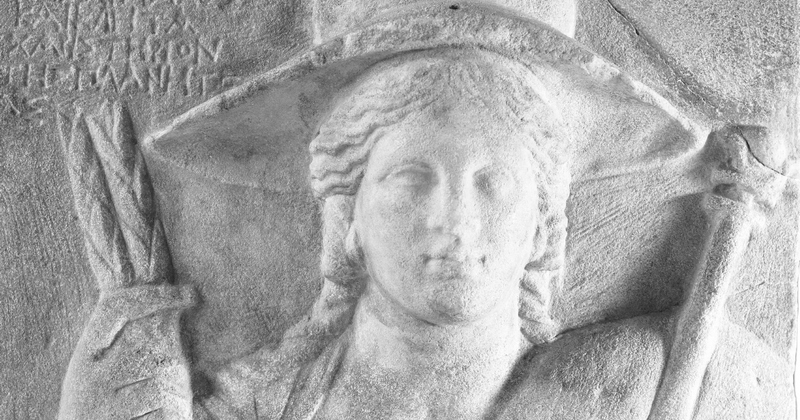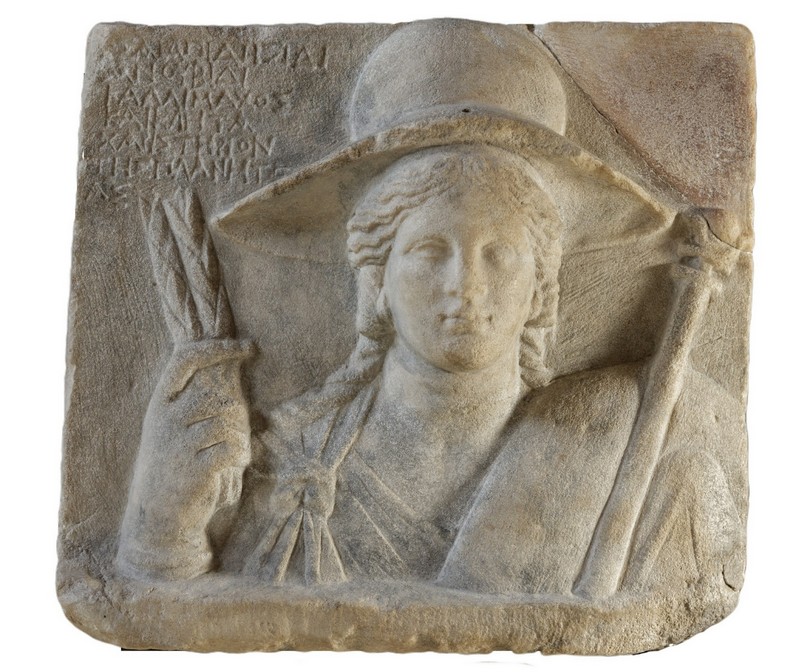An extremely interesting relief is exhibited in the Archaeological Museum of Dion. Dated to the end of the 3rd c. – early 2nd c. BC, it was found inside the Sanctuary of Isis, and it is a characteristic example of the iconographic syncretism of two female deities: Demeter and Isis. A female figure is depicted in bust form as goddess of fertility and agriculture, but her identity is recognizable due to her drapery tied with the Isiac knot on the right shoulder. She wears a broad-brimmed hat to which a crescent moon or some other symbol of Isis was attached. She holds ears of wheat and a scepter crowned with horns and the solar disc. A barely distinguishable object covers er left shoulder. It has been identified as a shield or more probable as a bag for ears of wheat.
The inscription that accompanies the relief informs us that the plaque was dedicated by a couple, Kallimachus and Kleta, to the divine triad Sarapis, Isis, Anubis. The text of the dedication has been much debated, because of the expression “charisterion (thank offering) tes planeteas”. The last word has been perceived as cult epithet of the goddess Isis meaning “the one who wanders”, but the phrase has a syntactic problem. One should expect a noun explaining the cause of the offering to follow “charisterion”. An explanation is that the engraver missed a letter from the word “planete(i)a”, which is an hapax, i.e. it doesn’t occur elsewhere, and means “the wandering”.
Although “planete(i)a” could refer to the travels of Isis, the votive character of the relief shows that the cause for the thank offering of Kallimachos and Kleta was not the mythical wandering of Isis, but a hopefully completed travel for commerce or pilgrimage. That recalls that Isis, along with other roles, was honored in many Greek cities as protectress of naval routes. The inscription possibly sheds light on another dimension of the cult identity of the goddess, who was worshiped at Dion mainly as Lochia.
Bibliography
Δ. Παντερμαλής, «Οι επιγραφές του Δίου», στο: Πρακτικά του Η΄ Διεθνούς Συνεδρίου Ελληνικής και Λατινικής Επιγραφικής, Αθήνα 3-9 Οκτωβρίου 1982, τόμ. Ι, Αθήνα 1984, 275.
Μ. Hatzopoulos, «Bulletin Epigraphique», Revue des Études Grecques 112 (1999), 634, αρ. 332.
Παχής Π., «Η έννοια της περιπλάνησης κατά τη διάρκεια των ελληνιστικών χρόνων», Επιστημονική Επετηρίδα Θεολογικής Σχολής Αριστοτελείου Πανεπιστημίου Θεσσαλονίκης, Νέα σειρά, τμήμα Θεολογίας, τόμ. 12 (2002), 273.
S. Pingiatoglou, «Relief inscrit représentant Isis, dédié à la triade égyptienne Sérapis, Isis et Anubis», στο: S. Descamps-Lequime (ed.) Au royaume d’ Alexandre le Grand. La Macédoine antique, Paris 2011, 498. αρ. 312.
P. Christodoulou, «Les reliefs votifs du sanctuaire d’Isis à Dion», στο: L. Bricault & R. Veymiers (επιμ.), Bibliotheca Isiaca II, Bordeaux 2011, 11-16.


